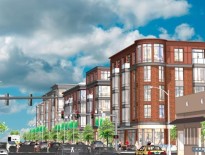When lawmakers reduced the corporate tax rate at the end of last year, it was supposed to open the flood gates for what had already been an extremely healthy economic climate.
While tax reform is expected to yield long-term benefits, it has yet to translate into the increased loan demand that bankers expected to see through the first quarter of 2018.
“We would have anticipated a little more enthusiasm expressed in higher loan demand as a result of the tax reduction,” Christopher Oddleifson, CEO of Rockland Trust Co. and its parent Independent Bank Corp., said on a recent earnings call. “The business level optimism is actually pretty high in our area, and going higher, and it was pretty high prior to tax reform. So we thought the icing on the cake would be tax reform and things would really kick in.”
But that has hardly been the case for some banks, particularly in the upper end of the market.
While Rockland grew total commercial real estate volume by about $75 million year-over-year as of the end of the first quarter, the portfolio lost about $14 million from the linked quarter.
Hartford, Connecticut-based United Bank, which has a large presence in Western Massachusetts, grew its commercial real estate book over $150 million between the first quarter of 2017 and 2018, but lost about $8 million in value from the linked quarter.
Boston Private saw its commercial and industrial lending volume decline year-over-year and from the linked quarter.
“Q1 loan growth was a bit softer than expected this year – with typical seasonality playing a role, but also really a lack of positive demand follow through to date from the reduction in tax rates that occurred at the end of 2017,” Chris McGratty, who heads Keefe, Bruyette & Woods’ small- and mid-cap bank research, said in an email update.

Bram Berkowitz
What Gives?
Tax reform alone cannot create loan demand; there are other factors at play in local economies; the impact of higher interest rates, for example.
“Our hypothesis is that we are seeing a lot of good cash flow in companies and with the slightly rising rates, they are paying a little more attention to their interest rate costs,” Oddleifson said. “So maybe managing cash position a little tighter and therefore mitigating some of the loan demand we would have anticipated. We don’t know for sure, but that is one of our hypotheses.”
Others didn’t – and still don’t – expect tax reform to impact loan demand at all.
John Patrick, CEO, president and chairman of Farmington Bank, with locations in Connecticut and Massachusetts, said tax reform is “too cerebral.”
East Boston Savings Bank CEO Dick Gavegnano said he has not seen any impact at all and is still seeing plenty of healthy demand. The bank’s commercial real estate portfolio totaled $2.25 billion at the end of the first quarter, up over $460 million year-over-year and about $190 million higher from the linked quarter.
Whatever the reason might be, the slowdown in demand appears to have led to a price war, with many banks experiencing spread compression.
“I think commercial real estate is certainly where you see the most [spread] compression. And that’s when I think about the 150 and 160 basis points over, that’s the asset class that we’re thinking of in terms of investor CRE,” United Bank CFO Eric Newell said on a recent earnings call. “I would say that six months ago, we could probably more easily do … 180 basis points to 200 basis points over. So, you’re seeing about 20 to 30 basis points compression. … And so sometimes, we make a choice to let that asset go off our books and go elsewhere.”
Rockland Trust’s CFO Robert Cozzone said he has seen recent spread compression to the tune of 50 basis points.
Boston Private CFO Steven Gaven said the competitive environment for commercial and industrial lending is extremely tough right now, and he is seeing some pricing spreads the bank does not feel comfortable with.
While demand has been modest and competition high, many bankers still reported feeling optimistic about the year ahead and expect to see turnarounds starting in the second quarter.
“All loan pipelines were stronger at the end of the first quarter when compared to prior year end, and loan growth should resume in the second quarter,” said Cozzone. “However, as Chris [Oddleifson] noted, the competitive environment seems to have intensified since year end and certainly bears watching.




 |
| 

